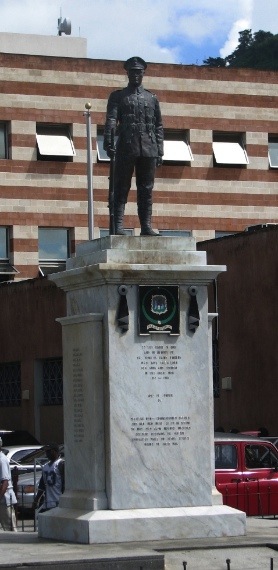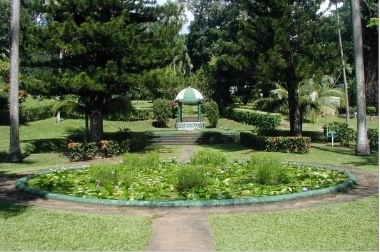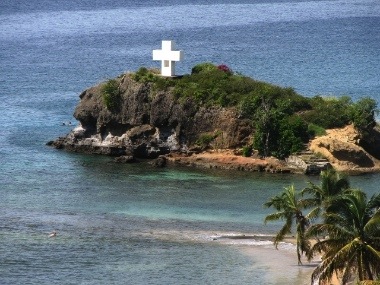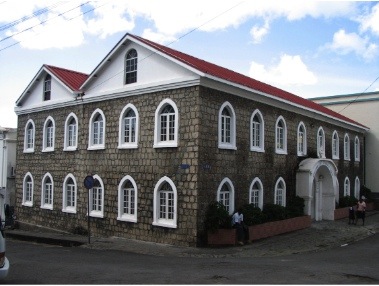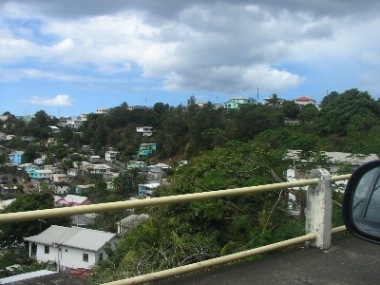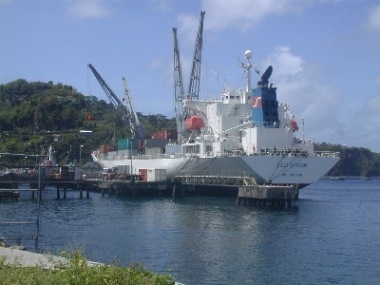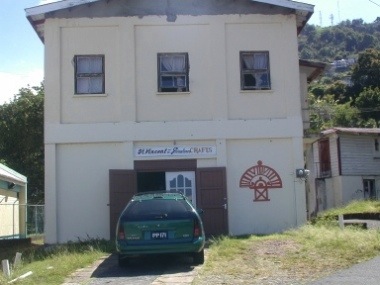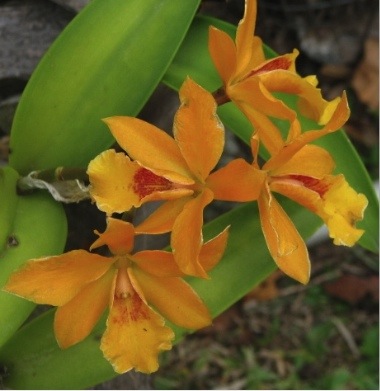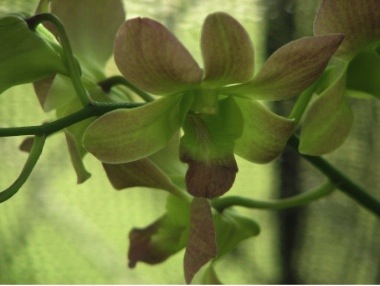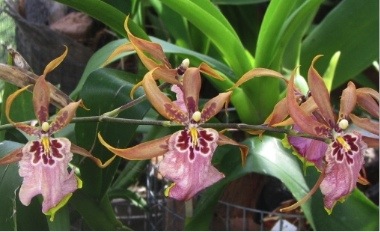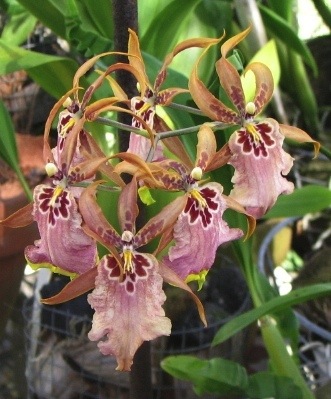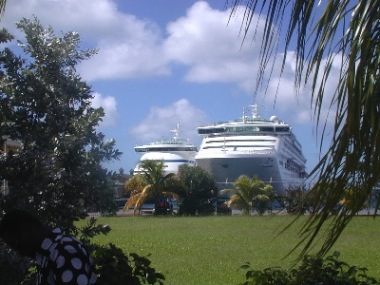[It has been some time since the last movie was shot in St. Vincent, but the remains of the sets are still a tourist attraction in Wallilabou. I ran across this on the web.]
On February 28th, 2005, the cast and crew of “Dead Man's Chest” packed their bags, kissed their loved ones, and wedged themselves into a chartered L-1011 jet bound for the distant West Indies…and a location journey of nearly a year's duration which would prove to be as much of an adventure as anyone could have predicted, and as much of a challenge as anyone could have imagined.
First destination: the island republic of St. Vincent and the Grenadines, 13 degrees north of the equator. Because it's not highly developed for tourism, which is one of its great charms, St. Vincent's airport cannot contain anything bigger than a two-engine prop commuter plane. Thus, the “Pirates” jet had to land on the neighboring island of St. Lucia, situated between St. Vincent and Martinique, and ferry the company, over rough seas for two hours, to their destination. And if seasickness was to become something of a motif throughout production, the “Pirates” crew had some good practice on that initial voyage.
Meanwhile, a monumental amount of equipment and materiel were already on their way to the islands via air and sea in a deployment which again echoed a military campaign. “Priority equipment went by air,” recalls unit production manager Doug Merrifield, “but we also chartered a freighter, loaded it up with all of our rolling stock and containers, and it sailed to St. Vincent, and later to Dominica and then to The Bahamas. It became afternoon entertainment for the island people to watch a procession from one end of the island to the other as our equipment came out of the port.”
Some 300 crew members were imported to St. Vincent from Los Angeles, Great Britain and many other home bases, with their numbers considerably increased by local islanders also employed in a myriad of departments. As St. Vincent lacks large resorts, crew members were housed at 43 different hotels, inns, bed and breakfasts, condos and apartments sprinkled across the western part of the island. For many in the company, it was old home week, as the first “Pirates” film shot in St. Vincent for nearly two months.
Also making the journey to the Caribbean was a veritable menagerie trained and accompanied by Boone Narr and Mark Harden from Animals for Hollywood, which included two capuchin monkeys, two macaws, a dozen goats, three pigs, two white horses, two carriage horses, three dozen chickens, six cows and 14 ravens. In the first “Pirates” film, some of the on-screen creatures-including the Prison Dog, Jack the Monkey and Cotton's parrot-had their moment of stardom, which was about to be repeated. The silent Cotton's parrot is actually portrayed by two macaws, spicy and spirited avian creatures appropriately named Chip and Salsa. “One's a good flyer, the other's a good sitter,” notes David Bailie, who portrays the tongue-less pirate. “God, if you heard him squawk! You have no idea what that squawk is like at a two-inch range. Your head just rings.”
The Prison Dog, a beloved character both in the original `Pirates of the Caribbean' attraction and the first film, is now played by Chopper, a friendly and unbelievably smart eight-year-old terrier mix. Twister, who portrayed the role in “The Curse of the Black Pearl,” is now enjoying a well-deserved retirement after years of film and television work. However, like many stars, Chopper needed time in the makeup trailer to correctly align the color of his coat with Twister's. “Chopper has an air-conditioned little trailer that he stays in, and sometimes he allows me to go inside,” says Boone Narr ruefully. “Then, on his day off, he expects me to run around and take care of him. Usually, I'm at his bark and call. He's got me well-trained.”
Once again, the beautiful inlet of Wallilabou Bay, due north from the island's small capital of Kingstown, would be the locale for both Port Royal and Tortuga exteriors. Rather than take the long and winding (and sometimes treacherous) road from Kingstown to Wallilabou, most in the company preferred to shuttle there on the water, a beautiful journey which skirted the lush shoreline dotted with palm trees, banana plantations, mountains often shrouded by clouds and brightly colored little houses. Some landlubbing crew members spent more time on the water in the first weeks of Caribbean filming than they had in their entire lives, careening back and forth from one of the three starting points in and around Kingstown to Wallilabou, enjoying the warm tropical breezes, sunshine and spectacular views. Of course, there was the occasional downpour and heavy ocean swells to deal with as well.
If someone with no connection nor knowledge of “Dead Man's Chest” found themselves sailing into Wallilabou during filming, they would have felt like they had slipped into a time tunnel and out the other end. The clock had seemingly been turned back nearly 300 years to the days when European hegemony over the Caribbean was constantly being challenged by the pirates who freely roamed the waters. Rick Heinrichs and his team re-created Port Royal in even greater detail than the first film, with the added structures of the East India Trading Company dock and offices. Anchored in the bay was an impressive array of period vessels, dominated by the 169 foot, full-rig H.M.S. Bounty, which in “Dead Man's Chest” is seen as the Edinburgh Trader.
The Bounty, like its real-life namesake, has had an extraordinary history of its own. She was built for Metro-Goldwyn-Mayer's 1962 version of “Mutiny on the Bounty,” which starred Marlon Brando, Trevor Howard and Richard Harris. The first ship ever built from the keel up especially for a motion picture, construction of the Bounty began in Lunenburg, Nova Scotia in February 1960, and spent seven months being constructed with more than 400,000 board feet of lumber in the Smith and Rhuland Shipyard before sailing for Tahiti and the production of the blockbuster feature.
Although the historical Bounty was 85 feet long, its cinematic reconstruction was 118 feet in length so as to allow the cameras more free movement during shooting, and her total height from deck to the top of the mainmast is 103 feet. For “Mutiny on the Bounty,” the ship made the 7,327 mile voyage from Lunenburg to Tahiti via the Panama Canal in 33 sailing days. Forty-three years later, the Bounty, under Captain Robin R. Walbridge, would be required to sail a mere 2,096 statue miles (1,821 nautical miles) in 14 days from Bayou La Batre-where she was being re-fitted and re-painted as the “Edinburgh Trader”-to St. Vincent, with stops along the way in Miami, Florida and Mayaguez, Puerto Rico for fuel and provisions.
The Bounty was joined in Wallilabou Bay by several more “picture boats” from near and far, under the supervision of marine coordinator Dan Malone, assistant coordinator Bruce Ross and picture boat coordinator Will White and their team, who were aided and abetted by boat captains, water safety personnel, technicians, sailmasters and handlers, the rigging crew under Courtney Andersen, and dockmaster Douglas “Kino” Valenzuela, who was often like a waterbound traffic director. Among them were: Sloop Providence, a 110-foot topsail fighting sloop, a replica of Rhode Island's first naval vessel, seen in “Dead Man's Chest” as the “Perseverance.”
The Providence departed its Rhode Island home for the Alabama shipyard in a blizzard in January 2005, and sailed from Bayou La Batre to St. Vincent in a swift 15 days; St. Peter, a 74 foot schooner from Antigua; and Unicorn, a 145 foot barque from its home base of St. Lucia, portraying “Terpsichore.”
The support flotilla in “Walli” included 12 support boats of various kinds, not to mention some dozen British longboats faithfully reconstructed from original 18th century plans.
The primary set in the new and improved Port Royal was Lord Cutler Beckett's imposing headquarters, with a huge map of the world clearly dictating his “today the Caribbean, tomorrow the world” philosophy. “We were re-visiting the Port Royal set from `The Curse of the Black Pearl.'” Says Rick Heinrichs, “and the challenge was to let the audience know they were in the same place, but also that some period of time had passed. Ironically, the original set was still there at Wallilabou two years after they shot the first film, and we were going to use what was left. Not two months before we shot there on `Dead Man's Chest,' a tremendous surge came up and knocked the remaining sets into the water. So we had to do a complete reconstruction.”
On the East India Company dock, set decorator Cheryl Carasik and her assistants created an array of cargo and goods. “We researched all of it, trying to imagine what they would be importing and exporting. We had special ivory tusks-not the real thing, of course-molded in Los Angeles, because ivory was highly coveted at that time. We had tea boxes, silk, chickens in cages, bundles. At the last minute, Gore wanted a little fishing village off to the side of where Lord Cutler Beckett's office was on the Port Royal set, so I actually went to the next village from Wallilabou Bay and saw how they dried their fish on mats made of sticks and bamboo. We bought fishing nets from them, as well as about 40 fresh fish!”
“I've never seen anything like it,” says Tom Hollander of his days of filming in Wallilabou Bay. “Only in this production can you turn around, look out of the window of the set, and see 850 people pulling up rigging on a huge old ship, with another ship sliding in behind it. It's hyper-real, in a way. The production design is wondrous, the level at which they're working is remarkable. We just wander into the sets and go, `Oh yeah, this looks good,' but obviously the most enormous kinds of work go into all this detail, and scale that I've never seen before.
These people are all experts at what they do, it's the most inspired sort of creativity.”“The sets for this film supports everything you do,” adds Jonathan Pryce, “because the authenticity and attention to detail are quite extraordinary. When we shot the scene in Beckett's Port Royal office with me and Tom Hollander, normally that would be a kind of fairly intimate scene probably shot inside of a studio soundstage. But in our film, you look out of the window and there's a whole world of life on the dockside going on. Ships are being loaded. Bananas are going up and down the gangplank. Boats are coming in and out. It's a great approach to filmmaking. It's a great mix of old-fashioned filmmaking and modern technology.”
Typical of the film's attention to minute detail was the enormous amount of goods that spilled out from property master Kris Peck's truck like a cornucopia. At one point, Peck and assistant propmaster Michael Hansen had eight prop trucks in all four countries in which “Dead Man's Chest” was filmed, waiting to supply whatever necessary to appropriately outfit an actor, extra or stuntplayer. Much of Peck's work was done in collaboration with Rick Heinrichs' art department, or, if there were mechanics involved, with special effects and other technical divisions.
For the pistols, swords, daggers and other weaponry, Peck worked closely with armorer Kelly Farrah, an expert in the field who's also quite an historian, as well as historical adviser Peter Twist, who served in the same capacity on the first film.Although many of the weapons are replicas or realistically fabricated from latex, Captain Jack Sparrow's sword is the real 18th century deal (although obviously, less lethal versions were used for the swordfighting sequences). “We have 300 swords, and they were all manufactured for this movie,” notes Peck. “The pirates' swords are down, dirty and grungy. We have dress swords for characters like Commodore James Norrington and Governor Weatherby Swann. Our Flying Dutchman crewmen have swords that are encrusted with oceanic life.”
Perhaps the most important prop of all, however, was the titular object-the dead man's chest itself, designed with intricate nautical motifs. “Gore made it very clear to us that since this was the title that was going to be on every billboard, poster, bus stop bench and grocery store line, he wanted us to get it as right as possible,” says Peck. “This integrated more departments than any prop I've ever worked on. The writers, the illustrators, the production designer, the sculptors, the molders and then on to the prop shop for the mechanics. It had to look unbreakable, like a cast iron skillet.”
As it was on the first go-round, the shooting in “Walli” was the biggest show in town for Vincentians. Just outside of the gates which ran across the perimeter of the set from the main road, hundreds of people were just “limin',” island patois for “hanging out,” chatting, partying and peering at the grand spectacle. From a distance, the huge helium lighting balloons prepared by gaffer Rafael Sanchez and his team, suspended in the night sky, presented a surreal sight to islanders and tourists alike.“
Vincys” are fiercely proud of their country, and took an almost proprietary joy in the fact that one of the most successful films in history had been partially filmed on their small but vibrant island…and now it was happening all over again. “'Pirates' - Our Movie!” was the headline of an article written by St. Vincent lawyer Vynnette A. Frederick for a local newspaper: “'Pirates' brought Hollywood home,” she wrote. “It put money in our coffers, brought jobs for our people, and above all else, we now have the right to brag that St. Vincent and the Grenadines, just like Trinidad and Jamaica, can be considered a `movie location.' Every time you drive along the Leeward Coast, it is almost impossible not to look out to the horizon and hope for a glimpse of the Black Pearl.”



